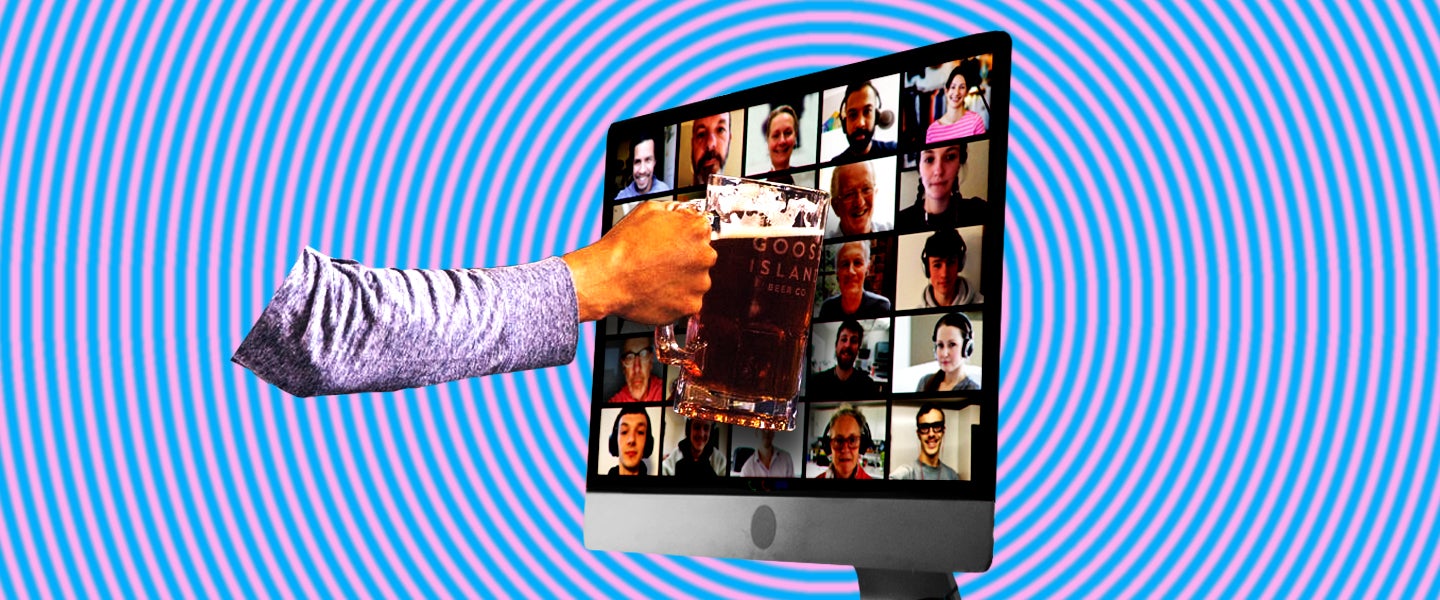It sounds fun in theory: You text all your pals, tell them to get their cocktails ready and join you on Zoom or Google Hangouts at the designated time. Then all six or ten or 14 of you log on, and it’s… awkward. Just as you start to ask one of them a question, someone else begins talking at the exact same time. You both go, “Oh, sorry, go ahead,” then still can’t decide who’s actually going to speak. Repeat this like, five times. That’s how most digital happy hours go.
Unless, of course, you have a plan. And a commitment to the “mute” button.
I don’t know what it is exactly about these virtual get-togethers that can be so dissimilar from the in-person experience. I’m sure you can blame the millisecond-long lags for much of it. This probably goes unnoticed when the party is small, so if you’re just looking to chat with no agenda, then you’ll want to limit the call to two screens. The number of screens is more important than the actual number of people involved — if a couple, family or group of roommates is sharing one camera, they basically function as one unit of the call.
Now, if you’re the closest of friends and never struggle to make conversation, I’d say four different units could have a casual happy hour and make it work. Maximum, six people, if you’re feeling funky.
But, if you’re willing to establish some kind of schedule, or some kind of organization to the whole event, your possibilities are endless. This requires assigning one person to be the moderator, of sorts. The moderator has a few choices. The first is to play a game of some sort. In my previous multi-person Google Hangouts, we’ve played Quiplash, part of Jackbox’s suite of games. With Jackbox, one person purchases the games (Quiplash is only $4.99 for perpetual use) and brings it up on their computer. They then “present” the game window to the Hangout, rather than streaming from their camera. This way, everyone can see the game, as well. Quiplash gives you a unique game code that players can use to log in to the game on their phones. Up to eight people can play the game at a time, but up to 10,000 people can be in the audience. Though it might not sound fun to just watch your friends play a game without you, it actually is.
There are other digital games intended to be played remotely like this, but you could probably even play charades or some kind of movie-based drinking game, too. The point is, there is something for everyone to follow without the constant need to make conversation.
Another option is to have the moderator give everyone the chance to give a presentation (more or less). This works particularly well for birthdays or other major events where one person is the focus, and everyone gets a chance to deliver some kind of sappy congratulations or recollection of embarrassing memories or whatever you like. Alternatively, everyone could just take a minute to say how they’re doing or what they’re up to. The call doesn’t have to stay regimented, but this way, everyone starts off on equal ground.
My bridal shower, with 12 friends from all over! They worked to make it as special as they could, from afar, complete with ridiculous games, happy tears, & gifts/pranks! It was pretty cool, because none of them really knew one another prior to being in our wedding party. https://t.co/0PzbdiWxri
— Boozy Brown Girl (@BoozyBrownGirl) May 20, 2020
Whatever you decide, if you have more than six different screens going, muting your mic is essential. According to Zack Gaudet, an IT support engineer, the number of people on a call doesn’t actually matter, but “a good rule of thumb is to mute your microphone if you’re not actively talking.” “I’m sure you’ve noticed that as soon as two people start talking over each other, you can’t hear or understand what they’re saying,” he continues. “Those issues can pop up with as few as three people on a Zoom/Hangout.”
Alternatively, he recommends getting a headset with a designated microphone, since they tend to pick up less miscellaneous sound around your house. Otherwise, if you’re not muted, your computer speaker will probably pick up the noise of your partner flushing the toilet or cooking dinner.
Finally, no matter how many people are involved, you’ve gotta use the grid layout if you’re not playing a game or doing it presentation style. If you’re going into it with no plans, it’s essential that you can all at least see each other and not just the one person who’s talking at that moment. Google currently supports 16 different grids, which is a pretty good limit to adhere to, anyway.
Really, though, do whatever the hell you want. If you hate planning, well, fuck it. But keep in mind that this is probably going to be a standard mode of communication for a looooong time — it’s better to keep it fresh and interesting while you still can.

